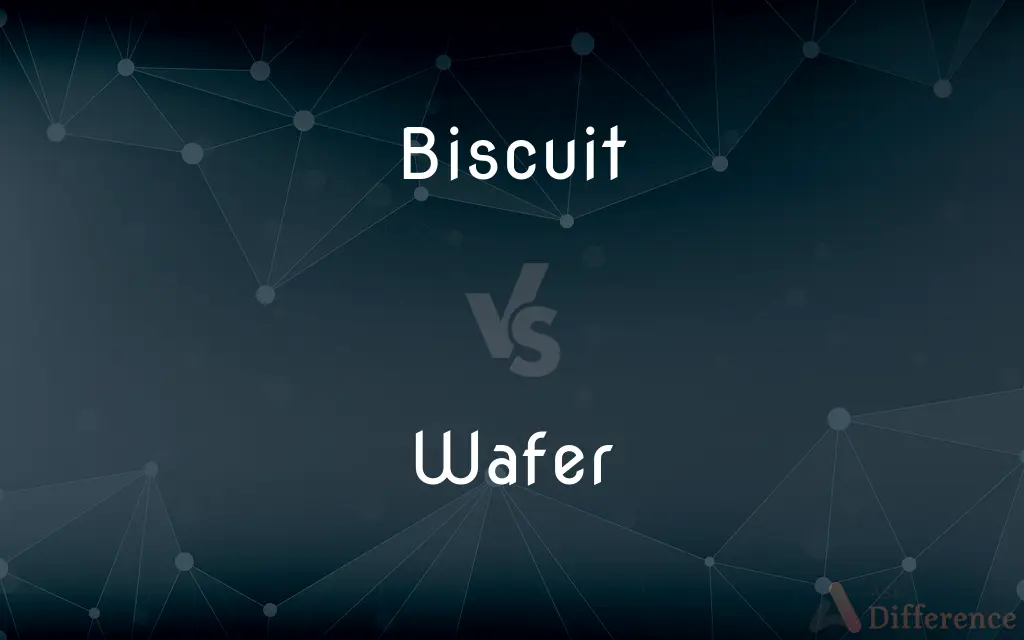Biscuit vs. Wafer — What's the Difference?
By Tayyaba Rehman & Fiza Rafique — Updated on March 27, 2024
A biscuit is a baked, typically soft or slightly crispy treat, often sweetened, whereas a wafer is a thin, crisp confection made from a batter and usually layered with a sweet filling.

Difference Between Biscuit and Wafer
Table of Contents
ADVERTISEMENT
Key Differences
Biscuits, as known in many parts of the world, are baked goods that come in various textures, from soft to crunchy, and can be sweet or savory. They're often enjoyed as a snack or part of breakfast, accompanied by tea or coffee. Wafers, on the other hand, are defined by their light, airy crispness and are frequently filled with flavored creams or chocolate, making them a popular ingredient in desserts or enjoyed alone as a sweet treat.
The preparation of biscuits involves creating a dough that is then shaped and baked. This process allows for a wide variety of shapes, sizes, and flavors, ranging from simple shortbread to complex, flavored varieties. Wafers are made from a thin batter that is cooked between two hot plates, similar to waffles, but much thinner and crisper, often leading to their characteristic grid-like surface.
In terms of texture, biscuits can vary greatly. Some are soft and chewy, like American-style cookies, while others are hard and crunchy. Wafers, however, are universally known for their lightness and crisp texture, which is achieved through their minimal fat content and the unique cooking method.
Culturally, biscuits hold a significant place in many culinary traditions, serving as comfort food, a snack for special occasions, or as part of a daily routine. Wafers, while also enjoyed worldwide, are particularly noted for their role in confectionery, often found in layered cakes, ice cream, and chocolate bars, showcasing their versatility in texture and flavor enhancement.
The flavor profiles of biscuits are as varied as their forms, incorporating ingredients like chocolate, nuts, and spices. Wafers, while simpler in their base form, are commonly paired with rich creams and chocolate, offering a contrast between the crisp wafer and the smooth, sweet filling, making them a favored light snack or dessert component.
ADVERTISEMENT
Comparison Chart
Definition
A baked, versatile snack, can be sweet or savory.
A thin, crisp confection, often layered with sweet fillings.
Texture
Ranges from soft and chewy to hard and crunchy.
Light and crisp, with a characteristic snap.
Preparation
Made from dough, shaped then baked.
Made from batter, cooked between two hot plates.
Flavor Varieties
Wide range, including chocolate, nuts, spices.
Often sweet, paired with creams or chocolate fillings.
Cultural Significance
Significant in many traditions, often enjoyed with tea or coffee.
Common in desserts and as a light snack, versatile in confectionery.
Usage
Eaten as a snack, with breakfast, or as dessert.
Used in desserts, ice cream, and as a standalone snack.
Texture Variation
Texture varies by type and ingredients.
Consistently light and crisp.
Compare with Definitions
Biscuit
A versatile baked good, ranging in texture and flavor.
She enjoyed a chocolate chip biscuit with her morning coffee.
Wafer
Characterized by its thin, airy texture.
The crispness of the wafer contrasted beautifully with the creamy filling.
Biscuit
Often paired with beverages like tea or coffee.
The afternoon tea was incomplete without a selection of biscuits.
Wafer
Frequently used in confectionery and desserts.
He layered the wafers with chocolate mousse for the dessert.
Biscuit
Can be sweet or savory, catering to diverse tastes.
For the party, he prepared both cheese and sweet biscuits.
Wafer
Known for its simple base and versatility in fillings.
The chocolate hazelnut wafer quickly became her favorite snack.
Biscuit
A staple in many culinary traditions around the world.
In her travels, she discovered the wide variety of biscuits enjoyed globally.
Wafer
A light, crisp snack often filled with sweet creams.
The vanilla wafer was the perfect light dessert.
Biscuit
Celebrated for its variety in texture, from soft to crunchy.
They debated whether a soft or crunchy biscuit was superior.
Wafer
Offers a unique texture contrast when paired with soft fillings.
The strawberry-filled wafer was a hit at the brunch.
Biscuit
A biscuit is a flour-based baked food product. In most countries, particularly in the Commonwealth and Ireland, biscuits are typically hard, flat and unleavened.
Wafer
A wafer is a crisp, often sweet, very thin, flat, light and dry cookie, often used to decorate ice cream, and also used as a garnish on some sweet dishes. Wafers can also be made into cookies with cream flavoring sandwiched between them.
Biscuit
A small baked unleavened cake, typically crisp, flat, and sweet
A chocolate biscuit
Wafer
A small, thin, crisp cake, biscuit, or candy.
Biscuit
Porcelain or other pottery which has been fired but not glazed
Biscuit ware
Wafer
(Ecclesiastical) A small thin disk of unleavened bread used in the Eucharist.
Biscuit
A light brown colour.
Wafer
(Pharmacology) A flat, tablet of rice paper or dried flour paste encasing a powdered drug.
Biscuit
A small flat piece of wood used to join two larger pieces of wood together, fitting into slots in each.
Wafer
A small disk of adhesive material used as a seal for papers.
Biscuit
A small cake of shortened bread leavened with baking powder or soda.
Wafer
(Electronics) A small, thin circular slice of a semiconducting material, such as pure silicon, on which an integrated circuit can be formed.
Biscuit
A thin, crisp cracker.
Wafer
To seal or fasten together with a disk of adhesive material.
Biscuit
A cookie.
Wafer
(Pharmacology) To prepare in the form of wafers.
Biscuit
A hard, dry cracker given to dogs as a treat or dietary supplement.
Wafer
(Electronics) To divide into wafers.
Biscuit
A thin, often oblong, waferlike piece of wood, glued into slots to connect larger pieces of wood in a joint.
Wafer
A light, thin, flat biscuit/cookie.
Biscuit
A pale brown.
Wafer
(Christianity) A thin disk of consecrated unleavened bread used in communion.
Biscuit
Pl. biscuit Clay that has been fired once but not glazed. Also called bisque2.
Wafer
A soft disk originally made of flour, and later of gelatin or a similar substance, used to seal letters, attach papers etc.
Biscuit
A small, flat, baked good which is either hard and crisp or else soft but firm; a cookie.
Wafer
(electronics) A thin disk of silicon or other semiconductor on which an electronic circuit is produced.
Biscuit
A small, usually soft and flaky bread, generally made with baking soda, which is similar in texture to a scone but which is usually not sweet.
Wafer
(transitive) To seal or fasten with a wafer.
Biscuit
A cracker.
Cheese and biscuits
Water biscuits
Digestive biscuits
Wafer
A thin cake made of flour and other ingredients.
Wafers piping hot out of the gleed.
The curious work in pastry, the fine cakes, wafers, and marchpanes.
A woman's oaths are wafers - break with making
Biscuit
(nautical) The "bread" formerly supplied to naval ships, which was made with very little water, kneaded into flat cakes, and slowly baked, and which often became infested with weevils.
Wafer
A thin cake or piece of bread (commonly unleavened, circular, and stamped with a crucifix or with the sacred monogram) used in the Eucharist, as in the Roman Catholic Church.
Biscuit
A form of unglazed earthenware.
Wafer
An adhesive disk of dried paste, made of flour, gelatin, isinglass, or the like, and coloring matter, - used in sealing letters and other documents.
Biscuit
A light brown colour.
Wafer
Any thin but rigid plate of solid material, esp. of discoidal shape; - a term used commonly to refer to the thin slices of silicon used as starting material for the manufacture of integrated circuits.
Biscuit
(woodworking) A thin oval wafer of wood or other material inserted into mating slots on pieces of material to be joined to provide gluing surface and strength in shear.
Wafer
To seal or close with a wafer.
Biscuit
A plastic card bearing the codes for authorizing a nuclear attack.
Wafer
A small adhesive disk of paste; used to seal letters
Biscuit
A handgun, especially a revolver.
Wafer
A small thin crisp cake or cookie
Biscuit
A puck (hockey puck).
Wafer
Thin disk of unleavened bread used in a religious service (especially in the celebration of the Eucharist)
Biscuit
(slang) The head.
Biscuit
A kind of unraised bread, of many varieties, plain, sweet, or fancy, formed into flat cakes, and bakes hard; as, ship biscuit.
According to military practice, the bread or biscuit of the Romans was twice prepared in the oven.
Biscuit
A small loaf or cake of bread, raised and shortened, or made light with soda or baking powder. Usually a number are baked in the same pan, forming a sheet or card.
Biscuit
Earthen ware or porcelain which has undergone the first baking, before it is subjected to the glazing.
Biscuit
A species of white, unglazed porcelain, in which vases, figures, and groups are formed in miniature.
Biscuit
Small round bread leavened with baking-powder or soda
Biscuit
Any of various small flat sweet cakes (`biscuit' is the British term)
Common Curiosities
What defines a biscuit?
A biscuit is defined by its baked nature, ranging from soft to crunchy, and can be sweet or savory.
Are biscuits and wafers served at the same occasions?
While both can be enjoyed as snacks, biscuits are often served with tea or coffee, whereas wafers are typically enjoyed as a dessert or light snack.
Are wafers considered a healthy snack?
While light, wafers often contain sweet fillings, so their healthiness depends on the ingredients used.
Can wafers be used in cooking?
Yes, wafers are frequently used in cooking, particularly in desserts like layered cakes and ice cream.
What is the main difference in preparation between biscuits and wafers?
Biscuits are baked from a dough, while wafers are cooked from a batter between hot plates.
How are wafers made?
Wafers are made by cooking a thin batter between two hot plates until crisp.
What makes wafers crispy?
The minimal fat content and the cooking method between hot plates give wafers their crispiness.
Can biscuits be homemade?
Yes, biscuits are frequently made at home with a variety of recipes available.
Can biscuits be savory?
Yes, biscuits can be savory, incorporating ingredients like cheese or herbs.
Do biscuits have a universal texture?
No, the texture of biscuits varies widely, from soft and chewy to hard and crunchy.
Are there gluten-free options for biscuits and wafers?
Yes, there are gluten-free recipes and commercial options available for both biscuits and wafers.
Do wafers always have a filling?
Not always, but they are commonly associated with and often enjoyed with fillings.
How long can biscuits and wafers be stored?
Both can be stored in airtight containers; however, their shelf life varies based on ingredients and preservatives.
Which is more versatile, biscuits or wafers?
Biscuits are generally more versatile due to their wide range of flavors, textures, and the option to be sweet or savory.
How do cultural perceptions of biscuits and wafers differ?
Cultural perceptions vary, with biscuits often seen as a comfort food or daily snack, whereas wafers are typically considered a treat or dessert component.
Share Your Discovery

Previous Comparison
Leaf vs. Leave
Next Comparison
Lonely vs. LonesomeAuthor Spotlight
Written by
Tayyaba RehmanTayyaba Rehman is a distinguished writer, currently serving as a primary contributor to askdifference.com. As a researcher in semantics and etymology, Tayyaba's passion for the complexity of languages and their distinctions has found a perfect home on the platform. Tayyaba delves into the intricacies of language, distinguishing between commonly confused words and phrases, thereby providing clarity for readers worldwide.
Co-written by
Fiza RafiqueFiza Rafique is a skilled content writer at AskDifference.com, where she meticulously refines and enhances written pieces. Drawing from her vast editorial expertise, Fiza ensures clarity, accuracy, and precision in every article. Passionate about language, she continually seeks to elevate the quality of content for readers worldwide.














































